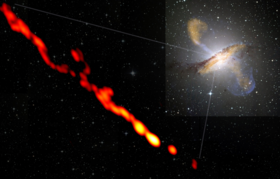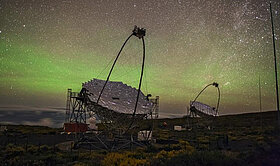Astronomy and Astrophysics

Our Universe is the ultimate laboratory to study the laws of nature. At the chair of astronomy and astrophysics, the main research focus is the part of the Universe which is out of thermal equilibrium. This non-thermal Universe consists of magnetized plasma and relativistic particles from cosmic accelerators and their emissions.
We are in contact with the non-thermal Universe through cosmic rays, a permanent bombardment of Earth by relativistic particles from space. The origin of cosmic rays is unknown, Mounting evidence suggests that cosmic rays originate from powerful supersonic outflows: supernova remnants, pulsar winds, and extragalactic jets emerging from accreting black holes in the centers of galaxies.
Astronomers at JMU Würzburg have access to internationally leading observatories across the electromagnetic spectrum, from radio wavelengths to X-rays and high-energy gamma rays. Observations are carried out by applying the astronomical techniques of very-long-baseline interferometry (VLBI) in radio astronomy, the imaging air Cherenkov method in gamma-ray astronomy (MAGIC, FACT, CTA), and direct detection with space-borne instruments (XMM-Newton, Fermi-LAT) in high-energy astronomy. Ancillary measurements of high-energy neutrinos and cosmic rays further constrain the nature of astrophysical sources in the non-thermal Universe.
We develop advanced analysis methods for the statistical interpretation of the data. Radio and gamma-ray astronomy generate Petabytes (and soon Exabytes) of data, requiring a highly efficient data management and automated monitoring of data quality. Machine-learning algorithms promise new avenues for the exploration of the astronomical big data.
On the theoretical side, our main focus is on models of radiation processes, particle transport, and particle acceleration mechanisms in the framework of physical descriptions of the astrophysical objects responsible for non-thermal emission (supersonic outflows from compact objects such as black holes or neutron stars). We also address their cosmological evolution, from stellar scales to the scales of active galactic nuclei and clusters of galaxies. Relativistic particles also affect the thermal Universe and its inventory, by feeding back with the processes involved in star formation or interstellar chemistry. Furthermore, we study dark-matter models in the cosmological context. It is possible that dark matter reveals itself through high-energy emission produced in decays or particle-antiparticle annihilations.
Some big questions are:
- Do cosmic rays originate in astrophysical radio- and gamma-ray sources?
- How do the recently discovered extraterrestrial neutrinos fit in?
- What powers extragalactic jets and how do they accelerate particles?
- Can we find the signatures of emission from the ergospheres of spinning black holes?
- Can we discover anomalies originating from rare dark matter?



